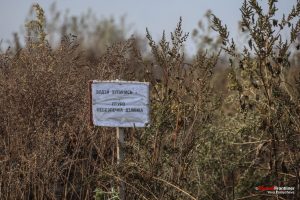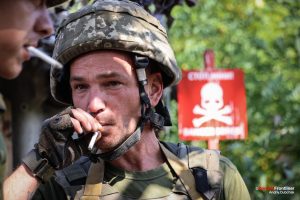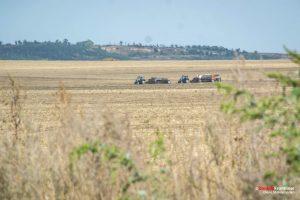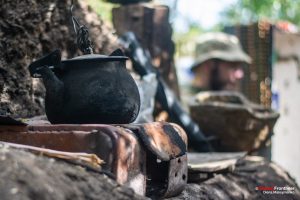Frontliner, an independent interactive media project launched by three Ukrainian journalists – Olena Maksymenko, Eva Fomycheva, Andriy Dubchak – publishes frequent reports and on-site photos of life in the trenches, covering both the military conflict and the hybrid war launched by the Russian Federation against Ukraine. Frontliner reporters and their crew are physically present on the front lines 24 hours a day seven days a week.
Frontliner reporters bring us this live report from eastern Ukraine.
They call themselves “Badgers”, referring to their commander, Vadym Sukharevsky, call sign “Badger”, commander of the 503rd Marine Corps Battalion and the first officer to open fire on the Russian invaders in 2014 near the city of Sloviansk. He is highly respected by all the soldiers and his call sign has been adopted by the Marines.

The “Badgers” are currently deployed in and around Verkhniotoretske, Donetsk Oblast.

Missiles were fired at a military vehicle a few meters from here… Photo: Eva Fomycheva
Only recently, 27-year-old Marine Artur Holub, who was driving his vehicle in the area, was killed by an ATGM as he was delivering food supplies to military positions at the front. His ghost-like burnt-out KamAZ, now no more than a steel skeleton, lies by the roadside. This road is currently closed.
It’s an ongoing and protracted war, and yet combine harvesters can be seen working in nearby fields. It’s that period of the year – time to gather the harvest… even though this peaceful field was shelled with mortars just a few days ago.

The first rotation, the first death
The winding path to the Ukrainian military positions resembles a long, thin snake slithering through high grass. At this point, the grass is our most reliable protection. We don’t need to run, and can walk upright. However, this grass area is also dangerous. The soldiers keep warning us not to step away from the path, not to touch the bushes, and if shelling starts, we should hit the ground on the spot, on the pathway, and not on the roadside. The fields are full of mines, and even the god of war doesn’t know where all these “little surprises” are located.
The soldiers are sad and depressed after the loss of their brother-in-arms. All of them knew Artur and liked him a lot, so they’re set on getting revenge. They tell us quietly that Artur was worth far more than a few enemy deaths.
“Yesterday our friend and brother-in-arms was driving along this road. He was delivering food when he died. He was leaving one of our posts, when ATGMs, launched from quite a distance, hit his vehicle. The second one killed him. They targeted two ATGMs. He had no chance of surviving. The whole day yesterday, I kept seeing his face and remembering the last few words we’d exchanged together. Well, this is war!” says “Santiago” sadly.

“Santiago” adds that he and Artur ususally spoke about everyday stuff, nothing really important. Like, one day, “Santiago” needed some tools and spare parts for his vehicle.
“He was a driver, so he helped me, told me where to find them,” the soldier says.
Another soldier arrives. His name is Yuriy; he stutters a bit as he speaks. His words are interspersed with long moments of silence.
“We were friends… we were close friends. Half an hour before he was killed, we talked and joked. We joked all the time. We took our exams together to get our marine berets. We always helped each other out. He was a really nice person and a great professional. He was simply a good guy.”

It’s the first rotation for Yuriy, and the first casualty. Before the war he worked in trading.
In his past life, “Santiago” worked with metal, as a blacksmith and welder. He admits that he’s always been a fan of weapons.
“I’ve loved guns since childhood. I know how to use them. I’ve always been close to guns. People around me also had weapons.” he remarks.

He says that he’s been serving in the Armed Forces for one year.
“I’ve been part of this war from the very beginning. Before, I helped the army and my friends on the front. I parted ways with 60% of the people who were around me after the Maidan. I had a clear and straightforward position, but most people were too afraid. When I raised a Ukrainian flag in my yard – I live in a private house in the countryside – some of the neighbors got scared! I live in Kyiv Oblast.” he laughs.
In and out of enemy shelling
The soldiers say that it’s rarely quiet here.

“We’ve just been deployed to this position. For three, four days in a row, this guy from over there has been coming out at the same time in evening and firing two missiles from the same point… on our positions. He works very quietly. There’s no sound of shooting, just a sudden “tuh-tuh-tuh”. Suddenly, he starts firing at us. As I understand, that person has come here for a “hunting safari”. He must have been paid a lot of money to hunt down people, to hunt and kill us,” says “Santiago”.
120-caliber mortar projectiles were fired for two days running. Over 20 shellings each day.

There were nearly 60 rounds of fire from 122-caliber barrel artillery. Enemy snipers work around the clock and so do their drones.

Forecasts for the fall are not very optimistic.
“They’ll probably start burning the grass. They have this really cool method… as soon as the grass dries up, they wait for the wind to blow in our direction and set fire to this dry grass. They have good and safe positions. The sun usually shines in such a way that it’s easy for their snipers to come out and take up a position. I came here in the evening three or four days ago. I brought some wooden logs to strengthen our dugouts. I put the logs down; suddenly, I felt something was wrong, so I dove straight into the trench… very, very quickly. Then, I just heard a quiet “bang” in the bushes. One bullet, one shot! Nothing else. No other sound,” says “Santiago.

Oleksiy Hodzenko, call sign “Godzilla”, press officer for the 503rd Marine Infantry Battalion, tells us that civilians are suffering as well.
“Just the day before yesterday there were around 60 attacks using 122-mm artillery. They hit the farming enterprise where combine harvesters work. One civilian vehicle, a Tavria, was damaged . The windows were smashed. You can even see a fragment still stuck in the glass.”

Not only is it a war “in the fields”, but also an information war. Hodzenko regularly monitors the enemy’s media resources and exposes their fakes. He says that their articles and posts repeatedly mention the legendary “badgers” and him personally.
“They shell us regularly, every other day. We can see lots of fake information in their Telegram channels. They mostly use Telegram. Two hours after Artur was killed, a fake appeared. They said that we were fooling around with our ammunition, and everything exploded. But, you can see the vehicle with your own eyes. It was burnt by an ATGM impact. The Kremlin horde is lying as usual, and in a bold and cynical way. It was the same story when they shelled civilians with artillery… they wrote that we’re all drunks and self-educated sappers. They churn out constant lies, starting on Telegram channels and ending on Russian federal channels.”

Here, as in many other positions on the frontline, soldiers use a land wire communication device. They refer to it as a “tapik” (TA-57). Despite its respectable old age (it was created in 1957), it’s more reliable than radio sets, which can be easily muffled.
Through the crackling of the “tapik”, we can make out a loud command – “Umbrella!” – a warning of possible shelling. We wait at the position for a while and start making our way back. The second round of shelling catches us right in the middle of the road. We hit the ground, wait in a trench and then run along the winding path to the so-called safe zone.
Here we can remove our bulletproof vests and helmets, sit down and rest. The soldiers here are more relaxed. They’re not on duty at the moment. They drink tea and clean their guns. There are mugs and bullets on the table, and as a contrast – one cup covered with hearts with an inscription “To my beloved Defender”.
We can hear shots in the distance. A coaxial grenade launcher firing.
“That’s our gun,” says one guy lazily. Later, we found out that one of those rounds had hit an enemy loophole.
The village and its people
From the hills we can see non-government controlled Horlivka. The village of Yasynuvata lies behind it.

The closest village is Verkhniotoretske.
The civilians in this place voice different opinions.
“Some of them are real separatists. We interviewed the security guard of a farming enterprise that had been shelled. One of the journalists asked him a question in Ukrainian. He answered in Russian, and refused to answer in Ukrainian. But, Baba Masha, for instance, whose home was also shelled five days ago, has a portrait of Taras Shevchenko in her house! I guess it’s like that everywhere. Most of the people here want peace. There are lots of separatists, but there are also normal people.” comments Hodzenko.

“Santiago” adds to the story: “We went to the local shop to get some stuff. A kid came up to us near the shop. He didn’t say a word. I don’t know, maybe he couldn’t speak. He just held out his hand, shook mine, and went away. That’s it. People are all different.”

Some civilians in Verkhniotoretske greeted us and the soldiers. While we were transferring the photos and video footage to our laptops, a young and not so sober lady approached us. Two kids were with her. She asked for a cigarette and started talking. First, she asked why all this shelling had started. Then, she got angry and started blaming the Marines. She claimed that before they came here it had been quiet and that the soldiers should stop provoking the enemy. Oleksiy Hodzenko answered patiently but firmly. Finally, the angry drunk lady left…
Shooting and shelling continued till the end of that day.

(The material was prepared with the support of the European Union and the International Renaissance Foundation within the framework of the joint initiative EU4USociety. The material reflects the position of the authors and does not necessarily reflect the position of the International Renaissance Foundation and the European Union).




